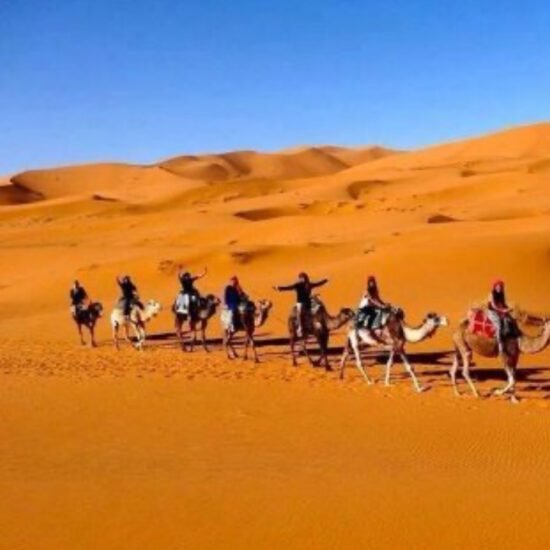
What is the Best Time of Year to Visit Merzouga
What is the Best Time of Year to Visit Merzouga?
Timing a trip to Merzouga, the crown jewel of Morocco’s Sahara Desert, can dramatically affect the depth and comfort of your desert experience. Its landscapes, the majestic dunes of Erg Chebbi, camel treks, and star-strewn skies beneath a sublime isolation, offer blissful serenity by day and sheer beauty by night. However, the very nature of desert weather alienates months either in level of accessibility or in level of enjoyment. This article looks into the best time of the year to visit Merzouga and will take into consideration the weather, activities, and travel logistics to help plan an unforgettable desert expedition.
Climate in Merzouga
Being a desert area, Merzouga is usually hot and dry with unusual temperature changes during the day and night.
Temperatures rise well above 45°C (113°F) in the heart of summer, whereas by night in winter the mercury drops dangerously close to freezing point. In contrast, these very fluctuations in temperature stand as the key determinants of what are the best months to actually heed a visit to the area for both practical and pleasurable purposes.
Spring (March, April, and May): The Peak of Desert Beauty
Spring time is widely accepted as the best time to visit Merzouga. While the day temperatures remain warm but bearable ranging between 20°C and 30°C (between 68°F and 86°F), activities such as camel riding, sandboarding, and trekking become comfortable with more ease.
These months witness a golden enactment of the dunes. A few rains seem to stir some desert vegetation for a moment with some colors, otherwise, it is a land of gold. Springtime also sets off the migratory pathways toward the neighboring Dayet Srji salt lake to make for surprising birdwatching.
During this period, the tourism industry experiences a slight rise, but given Merzouga’s scale, it never feels its suffocated with tourists. Besides, spring gives a perfect mixture of weather, scenic attraction, and action, making it ideal for the average traveler.
Autumn (From September to November): A Close Second Choice
Autumn avails the kind of similar features that grace this spring season, although the beginning of the season (especially the month of September) may still be highly impacted by the climatic heat of late summer. From October, a stability seems to come back in the temperature in the low 30s in Celsius (low mid-80s in Fahrenheit), providing magnificent conditions to tour.
This season offers the best treat to whosoever puts less value on crowds in spring and more on extreme temperatures from summer. Refreshing are the breezes that flow in the evenings, while the sunsets atop the dunes wear a heavy orange shade-perfect for the camera or two and some solace for lovers.
Winter (December to February): Quiet and Crisp
Wintertime in Merzouga beckons quieter, more introspective qualities of desert. During the afternoon, daytime temperatures go anywhere from 10°C to 20°C (50°F to 68°F), being perfect times for anyone loving cooler weather. Because a trade-off comes with an International business lies on warmer nights – the temperature usually falls close to 0°C(32°F) or less, especially during January.
Moreover, winter sunrise and sunset view will be far warmer and gorgeous than those at other times. The bears are merciful and perfect for daylight camel trekking. This time is ideal for tourists that are well aware of the drastic temperature change and love solitude in away from peak tourist traffic.
Camps and lodgings shall provide thick blankets and heaters, but it will be wise to carry layered outfits for maximum comfort. This calm and still ambiance engulfed by winter offers a spiritual encounter for the desert, wherein it beautifies those who find peace in silence and empty space.
Summer (June to August): Want Extreme Caution
Summer is not given much consideration for a Merzouga tour. With often temperatures exceeding 45°C (113°F) in the daytime, the whole outdoor experience turns hazardous.
Some tourists, however, still brave the heat for off-season rates and availability of private tailored bookings, but with the trips, extra consideration for safety and proper hydration is a must.
Timing and Cultural Festivals
Also, one should note when local festivals or holidays will occur, as these might either hamper some services or enhance your experience. The Merzouga International Music Festival, held sporadically, brings together traditional desert musicians and global artists in a lively setting framed by sand.
Religious holidays such as Ramadan shifts from year to year and can affect food availability during daytime hours. Having knowledge of the cultural calendar can better your interactions and provide a more immersive experience.
Conclusion: Choose Comfort, Not Just Calendar
When it comes to the question “best time to visit Merzouga,” comfort, interests, and expectations are factors to consider. Spring and autumn go for most; for the rare, lonely wanderers, it is winter; summer can be quite a trial. Besides weather, the real soul of Merzouga is more deeply revealed when consciously embracing the journey—allowing the gentle rhythm of the dunes, the twinkling of the stars, and the calming silence to be relished without haste.



